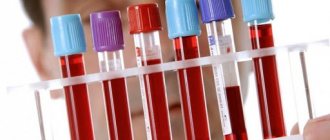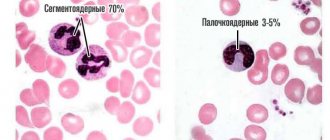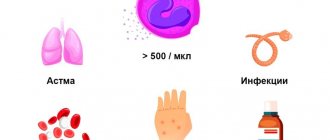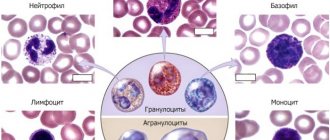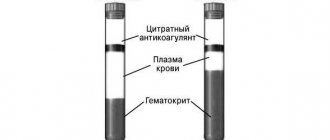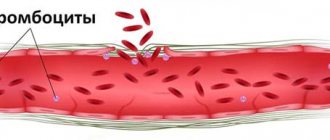The formed elements of blood represent a wide variety of specific structures of the body responsible for certain functions. In more detail, we are talking about a number of cytological units.
In total there are three large groups:
- Leukocytes. White blood cells. Responsible for the normal immune response. They act as a kind of protectors of the body. They work as a defensive force. There are several more subtypes of these cytological structures, but that’s a completely different conversation.
- Platelets. Red blood platelets. Perform several important functions. The key, if described superficially, is to quickly close the wound areas. They form a special plug that prevents blood from leaking out. There are other tasks, but they are secondary.
- Red blood cells. Red blood cells (RBC). They ensure normal gas exchange due to the fact that they are able to attach and transport oxygen and carbon dioxide. Without them there can be no normal life.
If the red blood cells in the blood are elevated, this may indicate infectious and inflammatory processes, disorders of the bone marrow, endocrine disorders, oncology and other diseases, that is, it is basically a sign of a pathological process. But not always.
We need to look into this in more detail.
Mechanism of development of the disorder
The formation of the conditional process is based on several pathogenetic factors. To put it in more detail.
Genetic disorders
They occur quite often. These are mainly those anomalies that are associated with a disorder of the bone marrow. But not only. This may include Pickwick's syndrome and some other abnormalities.
The point is that they are encoded at the genetic level and are inherited.
These are not phenotypic, random problems. Therefore, there are some difficulties with treatment and normal correction of pathological processes of this kind.
Bone marrow disorders
Multiple group of violations. Their essence lies in the abnormally high activity of the named structure. She begins to produce too many red blood cells.
Red blood cells are significantly elevated, which is typical for bone marrow disorders.
There can be many reasons: from artificial stimulation with drugs to genetic abnormalities, acquired pathological processes.
Infectious and inflammatory phenomena
Of different character. We can talk about a common cold, ARVI, or tuberculosis and diseases that are sexually transmitted. There are dozens of options, if not more.
The need to increase red blood cells is due to the body's significant need for oxygen. Fabrics need additional breathing and nutrition. This is important for metabolism under extreme conditions.
At a certain point, such tactics of the body may fail and everything will go to waste. The opposite phenomena will begin with hypoxia and ischemia of all organs and systems.
Oncology
Elevated red blood cells are also observed in oncological processes. As the tumors disintegrate, bleeding begins and the body needs to be more actively supplied with oxygen.
This mechanism also has a downside. The cancer cells themselves have to be fed, which also leads to an increase in the activity of tissues and body systems.
In certain cases, natural factors may influence. For example, excessive physical activity, poor nutrition. But these are rather exceptions. Plus, against the background of such phenomena, the increase is usually insignificant, within a few percent or less.
Classification Features
There are two types of erythrocytosis:
- Primary hereditary – refers to genetic pathologies, is rare. The source of the development of the disease is the low susceptibility of oxygen receptors in the kidneys and increased levels of erythropoietin. A sign of the disease is a pronounced loss of strength, attacks of dizziness, a change in the standard shade of the skin and mucous membranes into purple shades, and reduced blood clotting.
- Secondary or acquired - provoked by oxygen starvation of cells, occurs against the background of neoplasms in the liver, kidneys, and respiratory organs.
If the primary form of pathology is ignored, there is a risk of vascular complications, including thrombus formation. The problem is related to changes in the rate of blood clotting.
Reasons for growth
When red blood cells are elevated in a blood test, the condition is called erythrocytosis. The provocateurs of this are pathological in 98% of cases. If we talk in detail.
Respiratory disorders
Diseases of the upper and lower tracts. They occur quite often and are diverse in nature. If we make a conditional rating of pathological processes, the picture will be like this:
- Asthma.
- Bronchitis.
- Pneumonia.
- Laryngitis, tracheitis and other disorders.
It does not matter what kind of disease occurs in a particular clinical case. The point is different. The disruption is accompanied by a critical or slightly less severe drop in the quality of cellular respiration. After all, there is not enough oxygen supplied.
Normally, part of the gas remains motionless. The body simply cannot capture all O2 cells. As part of an emergency response to help itself, the body produces more red blood cells to make the most of the oxygen it receives. Adapt all resources intended to compensate for the condition.
If red blood cells are elevated due to respiratory diseases, this is a bad signal that indicates the development of hypoxia. As for possible symptoms, it depends on the underlying pathological process.
The basic manifestations for all disorders will be:
- Feeling of lack of air.
- Burning in the chest, in the projection of the trachea, bronchi, lungs.
- Discomfort during movements.
- Impaired consciousness.
- Weakness.
- Drowsiness.
- With an infectious genesis of the disorder, an increase in body temperature is possible.
High-quality treatment under the supervision of a pulmonologist is necessary. The issue can be resolved at home or in a hospital.
Several types of medications are used. Glucocorticoids, bronchodilators, antibiotics. It all depends on the pathological process and ways of its correction.
Diabetes
Classic endocrine disease. Accompanied by severe disturbances in cellular respiration and nutrition.
The deviation is characterized by a decrease in tissue sensitivity to insulin. Or the substance is produced in insufficient quantities. Both options are equally dangerous.
Why do red blood cells increase? The answer is simple: to compensate for the lack of oxygen, you need more cells that can carry it. As is the case with lung diseases.
Regarding symptoms:
- Breathing disorders.
- Heart problems.
- Decreased vision.
- Blood pressure surges.
- Memory and thinking disorders.
And this is only part of the possible manifestations of the pathological process. Treatment is carried out under the supervision of an endocrinologist.
Includes a triad of actions and activities:
- Loss of body weight.
- Diet correction. A special low-carbohydrate menu is being developed.
- Systematic use of insulin. According to need.
In some cases, the disease cannot be quickly corrected. Resistant forms are treated in a hospital.
Heart dysfunction
Pathologies of various profiles. These include the following anomalous processes:
- IHD. Coronary heart disease.
- Coronary insufficiency. When a meager amount of nutrients and oxygen reaches the myocardium through the arteries of the same name. A particular form of the condition described above is angina pectoris.
- Extreme degree of ischemia, acute disturbance of blood flow. The so-called heart attack.
- This also includes absolutely all possible heart defects. These are mainly valve dysfunctions. Mitral, tricuspid, aortic.
The reason for the increase in red blood cells is still the same - the body’s attempt to restore normal tissue respiration due to a larger number of cells.
The clinical picture is quite typical for all pathological processes of the described kind.
- Rhythm disturbances.
- Pain in the chest. Pressing or burning.
- Exercise intolerance. The so-called decrease in tolerance to it.
- Breathing disorders.
- Disorders of consciousness.
- Problems with motor activity.
- Weakness.
- Drowsiness.
- Tachycardia is the most common and at the same time the most isolated symptom.
Treatment is carried out under the supervision of a cardiologist. If we are talking about defects, they involve a specialized surgeon.
The goal is to quickly correct the disorder and stop its progression. Cardioprotectors are used. Mildronate and similar.
In the case of an anatomical defect, surgery must be performed. Suturing, plastic surgery or prosthetics. Depends on the shape and class of the defect.
Bone marrow disorders
There is also a fairly large group of pathological phenomena. Myeloproliferative diseases are possible when more cells than necessary are produced. Including immature ones.
There are other options as well. In any case, it is the bone marrow itself that is to blame. There are genetic and random, acquired forms of disorders.
Symptoms are invisible. At least in the early stages. Therefore, it is impossible to say for sure that there is a disorder in the functioning of the organ without a special examination.
It is carried out by a hematology specialist. The same goes for treatment. Glucocorticoids are used to slow down the production of formed cells.
If this does not help, suppressants are prescribed. They are much more powerful. The drugs inhibit the synthesis of structures, which is why health problems are possible. They select a strictly adjusted dosage so as not to make things worse.
Anemia
A disorder in which there is not enough hemoglobin in the blood. This substance becomes the main content of red blood cells. It carries oxygen and adds carbon dioxide.
To enhance and normalize tissue respiration, more red blood cells are produced. This does not make any serious sense, at least at advanced stages. Because there is catastrophically little substance.
There are several forms of the pathological process. Iron deficiency, megaloblastic and others. They are treated differently and produce different symptoms.
True, there are always some signs:
- Headache.
- Weakness.
- Drowsiness.
- Coordination problems.
- Brittle hair and nails.
- Bone strength disorders.
- More menacing manifestations are also possible. For example, with aplastic anemia.
Treatment is carried out under the supervision of a hematologist. The goal is to correct the source of the problem. The only way to help a person is conservative, medication.
Iron-based products and vitamin-mineral complexes are used. Other drugs are prescribed.
Infectious diseases
From acute respiratory to tuberculosis, syphilis and other dangerous pathological processes. The body is under stress.
In emergency mode, it functions to increase body temperature and restore normal operation of all systems.
This requires a lot of energy and, of course, oxygen. The transfer takes place on red blood cells. Since more of them are needed, the answer to why the cell concentration increases is obvious.
Symptoms depend on the diagnosis.
The most common signs are:
- Headache.
- Manifestations of general intoxication. Weakness, drowsiness, nausea, aching bones.
- Increased body temperature. Up to 37-39 degrees or more. Again, this is determined by the specific condition.
Recovery is carried out under the supervision of an infectious disease specialist and therapist. Antibiotics and antiviral agents are prescribed. Vitamin and mineral complexes. Antipyretics, also medications of the anti-inflammatory group.
All this to correct conditions. Or rather, to make it easier for the body to do its job. The prognosis is favorable in most cases.
Malignant tumors
A wide group of diseases for which infiltrative growth of neoplasms is typical. Simply put, movement through healthy tissue.
Also, neoplasia of a cancerous nature can metastasize and grow quite quickly. In some cases, this process is incredibly fast.
Regardless of the condition, the increase in the number of red blood cells is due to two main factors:
- If the tumor is intact, it needs more oxygen. Cancer cells are incredibly voracious. Hence the increased need for resources for one’s own growth.
- If decay begins, it is necessary to compensate for intoxication. Because more gases are needed.
Therapy and diagnosis of the pathological process are carried out under the supervision of oncology specialists. There are also related profiles, this is the main one.
The basis for the treatment of cancer is a triad of measures:
- Operation. The key task of the surgeon is to remove the tumor as much as possible. While it is small, it is easier to do this. In some cases, a significant portion of healthy tissue is captured to prevent the tumor from spreading further. Total excision is not always possible, therefore other methods are also practiced.
- Chemotherapy. Special drugs are introduced that kill “fast” cells. The ones that are rapidly dividing. Cytological units of hair, nails and, of course, cancer.
- Radiotherapy. Radiation therapy.
The prognosis depends on the type of oncology.
Burns
{banner_banstat9}
Especially massive ones. When the affected area is significant. In this case, the increase in the concentration of red blood cells is rather temporary, a reflex. Not due to the body’s natural need for help.
The deviation is accompanied by a group of symptoms, usually severe.
- Headache.
- Weakness.
- Drowsiness.
- Intense, sometimes unbearable discomfort at the site of the lesion.
- Impaired consciousness. Stupor, coma and, as a consequence, death from complications are possible.
- Heart disorders. Almost always.
The pathological process requires quick help. A group of specialists is working. Apply ointments and change antiseptic dressings. If possible, skin grafts are prescribed. There are plenty of options.
Therapy is carried out in a hospital, strictly under the supervision of medical personnel.
Vascular disorders
{banner_banstat10}
Mainly represented by vasculitis. Inflammatory processes that affect the internal lining of arteries, veins and capillaries.
But other pathological processes are also possible. Be it malformations, phlebitis, thrombosis.
The point is that blood cannot move along the riverbed at sufficient speed. Hence the disruption of normal nutrition and cellular respiration. The body acts in the only way - it increases the concentration of red blood cells. This, of course, makes little sense.
Recovery is carried out under the supervision of a hematologist and/or vascular surgeon. Depends on the clinical situation.
Several pharmaceutical types are used. Blood thinners are prescribed. Antiplatelet agents, anticoagulants.
For vasculitis, glucocorticoids are used to reduce the strength of the immune response. There are many options, doctors are working on them.
Changes in childhood
A pathological increase in the number of red blood cells in children is associated with various factors:
- with a low level of oxygen in maternal blood - the anomaly manifests itself in newborns;
- regular exposure of the baby to tobacco smoke (passive smoking);
- living in high mountain areas;
- regular sports activities.
A list of probable sources of deviation in children is presented:
- congenital heart defects;
- bone marrow dysfunction;
- hypertension in the pulmonary circulation;
- blood pathologies;
- obstructive pulmonary lesions with a chronic course;
- acute bronchitis, rhinitis or allergies;
- obesity of the last two degrees;
- dehydration caused by vomiting or diarrhea;
- disruption of the adrenal cortex.
Serious diagnoses associated with changes in the number of red blood cells include cancer of the kidneys and liver. Erythrocytosis is not an independent disease; it indicates latent pathologies or the presence of external influence factors.
Selected reasons for women
Basically the same as in general. But there are some additional points. For example.
Menstrual cycle
A temporary and slight increase in the concentration of red blood cells is possible. Not necessarily, but it does happen. This cannot be called a pathological process. You don't need to do anything. Everything will return to normal on its own.
Pregnancy
The same applies to the gestational period. Especially often, an increase in the concentration of erythrocytes is observed at the initial stage and at the very end of the natural process. No special treatment is required.
Normal indicators
The level of red blood cells contained in the bloodstream depends on the gender and age group of the patient. For a healthy person, the following level is acceptable:
- women – 3.7-4.7*1012 per liter;
- men – 4-5.1*1012 per 1 liter.
In childhood, the concentration of corpuscles constantly changes; for each month or day of a newborn’s life, there is a certain standard. Small fluctuations are observed after the first year of life, but the values are not particularly different from the same data for adults. At 12-13 years of age, the indicator is equal to adult values.
Selected causes in children
All of the above factors can occur in younger patients just as in adults. But there are two separate causes, diagnosed mainly in children.
Genetic abnormalities
Which were mentioned above. They show up pretty quickly. Usually based on objective signs and symptoms. Blood only confirms suspicions, like other studies.
Pediatric diseases
Elevated red blood cells in a child’s blood can be a result of whooping cough, scarlet fever, or chickenpox. This doesn't play a big role.
As is already known, infectious diseases provoke a pathological process and an upward deviation in indicators.
Prevention of increased red blood cells
The cause of the increased production of red blood cells is determined by the doctor. To maintain normal red blood cell levels, it is enough to adhere to preventive measures.
To avoid increased blood concentrations, it is recommended to drink more fluid. The water must be purified, so it is better to buy it in bottles or collect it from wells.
Eating fresh vegetables and fruits has a good effect on blood composition. They contain many vitamins and microelements that regulate the content of red blood cells.
You can reduce the concentration of red cells in the blood by eliminating foods containing iron from your diet. You will have to give up red meat, liver, beans, lentils, spinach, cabbage, prunes and raisins. Avoid drinking caffeinated drinks, smoking or taking aspirin. Regular physical activity will help regulate red blood cell levels.
When is MCV prescribed and why is it needed?
This analysis has two main goals:
- Differential diagnosis of anemia.
- Determination of water and electrolyte imbalances.
Determination of the MCV indicator is included in the general blood test and does not require special preparation. It is advisable to donate blood on an empty stomach. Capillary blood is used (analysis is taken from a finger).
Prescribed to patients with anemia, metabolic disorders and severe concomitant pathologies.
This analysis can identify the type of water-electrolyte imbalance. Thus, with macrocytosis, hypertonic overhydration is likely, and with microcytosis, hypotonic dehydration is possible. It goes without saying that this is just an auxiliary method that gives us one of the signs of a particular violation.
A little about anisocytosis
Anisocytosis is the presence of red blood cells of different sizes in the blood - from microcytes to macrocytes. Quantitatively, the distribution of red blood cells by volume is expressed in a special index, designated RDW.
This is what the distribution width of erythrocytes by volume curve looks like in the analysis
Red blood cell heterogeneity by volume (RDW) shows the deviation from the standard volume, expressed as a percentage.
Anisocytosis can be determined by a blood smear under a microscope, but the exact characteristics of these indicators are obtained using hematological analyzers. Interpretation of the results is carried out by laboratory diagnostic doctors together with MCV and facilitates the diagnosis of anemia.
Normally, the width of the distribution of red blood cells is 11.5-14 percent. You should know that if MCV is reduced with normal RDW, then this is typical for blood transfusion, removed spleen, and thalassemia.
If MCV is elevated with normal RDW, then most likely there is liver pathology. If RDW is elevated and MCV is below normal, beta thalassemia, iron deficiency, or red blood cell sludge may be suspected.
If suddenly both indicators are higher than normal, then we can assume cold agglutination, vitamin B12 deficiency or impaired absorption. This combination is also typical after a course of chemotherapy for cancer.
